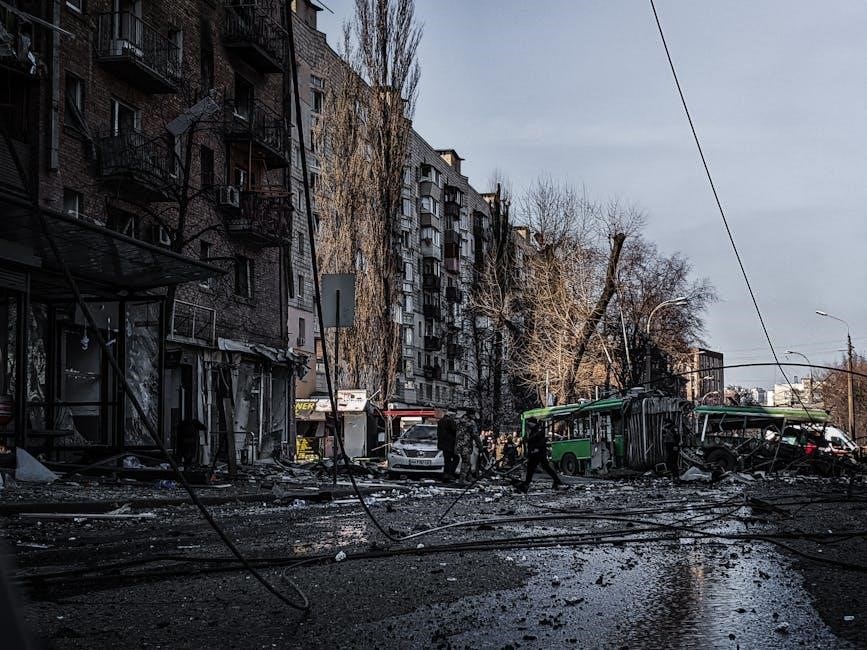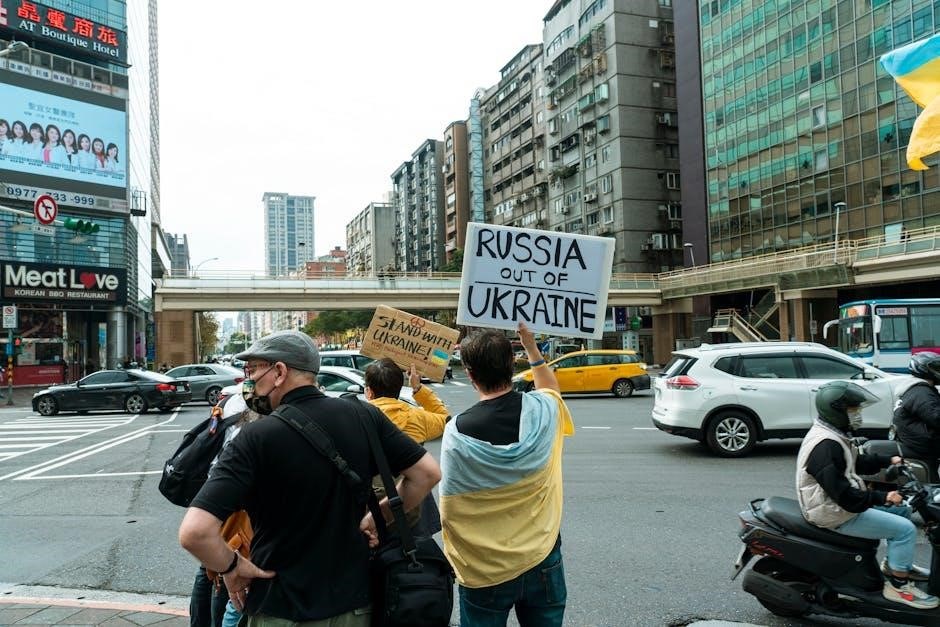The interwar period saw rising tensions fueled by economic instability and aggressive nationalism. Japan’s expansion in Asia and fascist regimes in Europe destabilized global peace, leading to WWII.
Overview of the Concept
The move to global war refers to the series of events and policies that escalated tensions between nations, leading to the outbreak of World War II. This period saw aggressive expansion by fascist regimes, economic instability, and the failure of diplomatic efforts to maintain peace. The concept examines how global conflicts arose from interconnected political, economic, and military factors, highlighting the transformation of localized disputes into a worldwide catastrophe. Key themes include imperialism, nationalism, and the collapse of international cooperation.
Historical Context and Significance
The move to global war is deeply rooted in the aftermath of World War I, economic instability, and rising nationalism. The Great Depression exacerbated tensions, while fascist ideologies in Europe and Asia fueled aggressive expansion. Japan’s invasion of Manchuria and Germany’s remilitarization of the Rhineland highlighted the failure of the League of Nations to enforce peace. These events underscored the collapse of international cooperation and the descent into a second global conflict, reshaping the world order.

Japanese Expansion in Asia (1931–1941)
Japan’s aggressive expansion began with the Manchurian Incident in 1931, driven by economic needs and military ambitions. This marked the start of its imperialist actions in Asia.
The Manchurian Incident and Its Aftermath
The Manchurian Incident in 1931 involved Japan’s Kwantung Army falsely blaming Chinese for a railway explosion. This justified Japan’s invasion of Manchuria, leading to the establishment of the puppet state Manchukuo. The League of Nations condemned the aggression, but its inaction emboldened Japan. The incident marked the beginning of Japan’s aggressive expansion in Asia, undermining regional stability and setting the stage for further conflict in the Second Sino-Japanese War.
The Second Sino-Japanese War
The Second Sino-Japanese War began in 1937 with the Marco Polo Bridge Incident, escalating Japan’s invasion of China. The conflict saw widespread atrocities, such as the Nanjing Massacre, and the establishment of a puppet government in China. The war weakened the Kuomintang and strengthened the Chinese Communist Party, leading to a unified resistance. It also drew international condemnation, further isolating Japan and contributing to the broader tensions leading to World War II.
Japan’s Economic and Military Motivations
Japan’s expansion was driven by economic needs and military ambitions. The Great Depression worsened Japan’s economic instability, prompting a shift toward autarky and resource security. Militarily, Japan sought to expand its empire to secure raw materials, particularly oil and iron, and strategic territories. The Imperial Japanese Army’s influence grew, leading to aggressive policies in Asia. These motivations underpinned Japan’s invasion of Manchuria and subsequent wars, aiming to establish a self-sufficient empire and counter Western dominance.
Rise of Fascism in Europe
Fascist ideologies emerged in Germany and Italy, fueled by economic instability and nationalism. Hitler and Mussolini’s aggressive expansionism destabilized Europe, leading to militarism and WWII.
Germany: Hitler’s Foreign Policy and Expansion
Hitler’s aggressive foreign policy aimed to overturn the Treaty of Versailles and expand German territory through Lebensraum. Key actions included remilitarization of the Rhineland, annexation of Austria, and exploiting the Sudetenland crisis to seize Czechoslovakia. His expansionist ambitions culminated in the invasion of Poland in 1939, triggering World War II. The League of Nations’ failure to intervene emboldened Hitler, while Britain and France’s appeasement policy only delayed the inevitable conflict.
Italy: Mussolini’s Imperial Ambitions
Mussolini sought to establish Italy as a dominant power, pursuing imperial expansion in Africa and the Balkans. His regime invaded Ethiopia in 1935, defying the League of Nations, and annexed Albania in 1939. Mussolini’s vision of a “New Roman Empire” aligned with Hitler’s ambitions, leading to the formation of the Axis alliance. Italy’s aggressive foreign policy contributed to regional instability and ultimately to the outbreak of World War II.
The Policy of Appeasement

Appeasement was a diplomatic strategy aimed at avoiding war by giving in to aggressive powers’ demands. Britain and France hoped to satisfy Hitler by allowing Germany to annex the Sudetenland in 1938. However, this policy emboldened Nazi aggression, leading to further territorial demands. The failure of appeasement became evident when Germany invaded Poland in 1939, prompting Britain and France to declare war. This approach ultimately accelerated the move toward global conflict rather than preventing it.
The Role of the League of Nations
The League of Nations was established to maintain global peace but failed to prevent aggressive expansion due to lack of enforcement powers and member cooperation. Its inability to address invasions in Manchuria and Abyssinia exposed its weaknesses, ultimately contributing to the breakdown of international stability and the move toward global war.
Failure to Prevent Aggression in Asia and Europe
The League of Nations failed to halt Japanese aggression in Manchuria and Italian conquest of Abyssinia due to ineffective sanctions and lack of member unity. Its inability to enforce decisions emboldened aggressors, while its reliance on voluntary cooperation and absence of major powers like the U.S. and Germany further weakened its authority. This ineffectiveness in addressing crises allowed fascist regimes to expand unchecked, undermining global stability and paving the way for World War II.
Economic Sanctions and Their Ineffectiveness

Economic sanctions imposed by the League of Nations against aggressive powers like Japan and Italy proved ineffective due to limited participation and loopholes. Nations prioritized economic self-interest, avoiding measures that might harm their trade. Additionally, targeted states often found alternative markets or relied on domestic production, reducing the impact of sanctions. This ineffectiveness emboldened aggressors, highlighting the weakness of economic coercion in preventing military expansion.

Global Economic Factors
The Great Depression destabilized economies globally, fostering protectionism and trade wars. Economic instability fueled nationalist policies, weakening international cooperation and heightening tensions leading to global conflict.
The Great Depression and Its Impact on International Relations
The Great Depression caused global economic instability, leading to widespread unemployment and poverty. Nations adopted protectionist policies, such as tariffs, which exacerbated trade wars and weakened international cooperation. Economic hardship fueled nationalist sentiments, fostering aggressive expansionism. The collapse of the global economy strained diplomatic relations, creating an environment in which militaristic and authoritarian regimes gained power, ultimately contributing to the outbreak of World War II.
Protectionism and Trade Wars
The Great Depression led nations to adopt protectionist policies, such as tariffs and trade barriers, to protect domestic industries. The Smoot-Hawley Tariff in the U.S. sparked retaliatory measures worldwide, deepening economic crisis. Trade wars reduced international cooperation, fostering economic nationalism. This environment of distrust and competition exacerbated global tensions, creating fertile ground for aggressive expansion by nations like Japan and Germany, which sought resources and markets through conquest rather than diplomacy.

Military Build-Up and Rearmament
Nations like Japan and Germany pursued aggressive military expansion, with Japan focusing on naval growth and Germany remilitarizing the Rhineland, fueling an arms race and destabilization.
Germany’s Remilitarization of the Rhineland
Germany’s remilitarization of the Rhineland in 1936 violated the Treaty of Versailles and the Locarno Pact. This bold move demonstrated Hitler’s aggressive foreign policy, testing the resolve of Western powers. The lack of significant opposition emboldened Nazi expansionism, marking a critical step toward WWII. This act showcased Germany’s resurgence and the ineffective response of the League of Nations, highlighting the weaknesses of the interwar peace settlements.
Japan’s Naval Expansion

Japan’s naval expansion in the 1930s was driven by imperial ambitions and economic needs. The withdrawal from the Washington Naval Treaty allowed Japan to build a formidable navy, focusing on aircraft carriers and battleships. This buildup facilitated military campaigns in Asia-Pacific, aiming to secure resources and territory. The expansion weakened international naval agreements and heightened regional tensions, contributing to Japan’s aggressive foreign policy and the outbreak of WWII in the Pacific.

The Americas and Isolationism
The Americas, particularly the U.S., adopted isolationist policies during the interwar period, avoiding foreign entanglements. Latin America faced economic challenges and political instability amid global tensions.
United States’ Neutrality Acts
The U.S. Neutrality Acts of the 1930s aimed to avoid involvement in global conflicts by banning arms sales and restricting financial aid to warring nations. These laws reflected widespread isolationist sentiment, seeking to prevent repetition of World War I’s losses. Initially popular, they later proved restrictive as tensions escalated, limiting the U.S.’s ability to support allies before World War II. The acts were gradually repealed as global threats intensified.
Latin America’s Response to Global Tensions
Latin America faced economic instability and political upheaval during the 1930s due to the Great Depression. Many nations adopted nationalist policies to protect their economies. Some, like Argentina and Brazil, maintained neutrality in global conflicts, while others, such as those in Central America, were influenced by U.S. foreign policy. The region also saw the rise of fascist-like movements inspired by European ideologies. These factors shaped Latin America’s complex and varied response to escalating global tensions. Economic and political shifts dominated the era.
The Outbreak of World War II
Germany’s invasion of Poland in 1939 triggered the outbreak of World War II, prompting declarations of war by France and Britain, escalating global conflict.
The Invasion of Poland and the Declaration of War
On September 1, 1939, Germany launched a surprise attack on Poland using Blitzkrieg tactics, quickly overwhelming Polish defenses. This act of aggression prompted Britain and France to declare war on Germany on September 3, marking the official start of World War II. The invasion of Poland was a direct violation of the Treaty of Versailles and exposed the failure of the League of Nations to maintain peace. This event cascaded into a broader conflict, drawing in more nations and reshaping global geopolitics.
The Spread of Conflict to Other Regions
The invasion of Poland triggered a chain reaction, spreading conflict globally. Japan continued its aggressive expansion in Asia, while Italy pursued imperial ambitions in Africa. The Battle of the Atlantic escalated tensions between Germany and the Allies, impacting trade and neutrality in the Americas. Meanwhile, the Soviet Union’s actions in Eastern Europe and Scandinavia further complicated the geopolitical landscape. These developments transformed a regional conflict into a truly global war, involving multiple theaters and nations worldwide.
The move to global war highlights the intersection of economic crises, nationalist ambitions, and failed diplomacy, setting the stage for unprecedented devastation and reshaping the world order;
Key Lessons from the Move to Global War
The move to global war underscores the dangers of unchecked nationalism, economic instability, and appeasement policies. It reveals how aggressive expansion, coupled with weak international responses, can escalate conflicts. The interplay of historical events, such as Japan’s invasion of Manchuria and Germany’s remilitarization, highlights the importance of collective security and diplomacy in preventing global crises. These lessons remain relevant for modern international relations and conflict resolution strategies.

Legacy of the War in Modern International Relations
The move to global war shaped modern international relations by establishing institutions like the United Nations to promote peace and security. It also led to the European Union, fostering unity to prevent future conflicts. The war’s legacy includes the Cold War rivalry, decolonization, and the rise of the U.S. and Soviet Union as superpowers. Additionally, it emphasized the importance of diplomacy, economic cooperation, and international law in maintaining global stability and preventing similar catastrophes.
